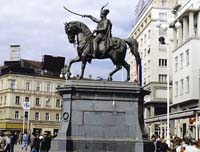
Zagreb, capital of Croatia, is the country's economic centre and gateway to Western Europe. The city is sited on the slopes of Medvednica Mountain along the banks of the Sava River, in the northern part of Croatia. The core of the city consists of the preserved medieval city, known as Gradec and Kaptol, while the residential area covers the southern slopes of the Medvednica Mountains. Since the 1950s the city has grown appreciably to the south of the Sava River, and the main industrial area is in the southeast. Besides being a commercial hub Zagreb is a tourist centre, and a popular international conference venue, with a history dating back nearly a thousand years. It is rich in historical monuments, museums and galleries, has modern shops, restaurants, sport and recreation facilities and a good transport infrastructure. Its attractions are largely historical, dating from the Palaeolithic Veternica Cave, through Roman culture and the fascinating medieval old town.
Attractions
| Andautonia Archaeological Park |
Near the village of Scitarjevo, close to Zagreb, are the remains of the ancient Roman town of Andautonia, which have been excavated and provide a fascinating tourist attraction. Andautonia was a prominent administrative, economic, cultural and religious centre about 400 years ago. Archaeologists are still excavating the site, but visitors can view a 26,910 square foot (2,500 sq m) area of the Roman City including parts of the main street, city baths, colonnades and side streets. Tourists can also visit the present-day village of Scitarjevo, which offers examples of typical rural farms with their characteristic wooden houses.
| | 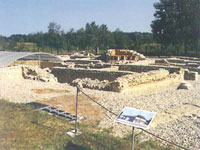 |
The building that houses Croatia's history is itself a part of that history. Sited in the historical town centre, it is the beautiful Baroque palace, Vojkovic-Orsic-Rauch, built at the end of the 18th century and formerly the private residence of three successive baronial families. In the late 1930s the palace became the residence of Zagreb's mayors, before being designated as a repository for the historical relics of the city. It currently houses more than 140,000 artefacts in various collections, from stone monuments to fine art, religious artefacts to heraldry. The exhibitions are not permanent but constantly changing so that all the collections get an airing.
| | 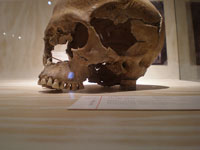 |
| Croatian National Theatre |
The building housing the Croatian National Theatre is as much a national treasure as the world-class dramatic, opera, music and ballet productions that take place on its stage. Construction began on the theatre building in 1894. Croatian painter Vlaho Bukovac painted the ceremonial curtain while Viennese artist Alexander Goltz decorated the ceiling of the auditorium. The building was officially opened by Austro-Hungarian emperor Franz-Joseph I at the end of 1895. The theatre is constantly busy with full performing arts programmes.
| | 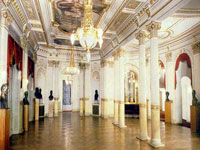 |
Praska Street, in the lower part of old Zagreb, leads on to a sequence of attractive park squares, each flaunting their own attractions and worth a walking tour. Zrinski Square features a music pavilion dating from 1895 and fountains, with the Archaeological Museum at No.17. This square also features a row of busts of distinguished Croatians and the palace of the Croatian Academy of Arts and Sciences (1876), which houses the Strossmayer Gallery of old masters. On Strossmayer Square is a monument to bishop Josip Juraj Strossmayer, founder of the Academy, and several other historic buildings. Tomislav Square features the Art Pavilion, fronted by a monument to Croatian Renaissance painter Andrija Medulic. King Tomislav rises on horseback at the southern end of the square. Starcevic Square is home to the City Library and Hotel Esplanade, and gives access to the Botanical Gardens and Frane Bulic monument. In Marulic Square the University Library building stands as a magnificent example of Art Nouveau. Mimara Museum is on Roosevelt Square, and the neo-Baroque Croatian National Theatre stands on Marshal Tito Square.
| | 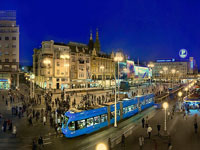 |
Trakoscan is a legendary 13th-century Gothic castle that was home to various influential families for centuries before finally falling into abandoned disrepair in the second half of the 18th century when it belonged to the Draskovic family. In the 1950s the castle was taken over by the state and turned into a living museum, reconstructing life in a medieval castle. Visitors can explore four levels, including the dungeon, and finish their exploration by enjoying the surrounding parklands.
| | 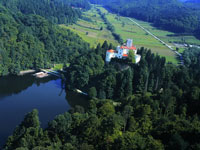 |
| Plitvice Lakes National Park |
The Plitvice Lakes have been declared a world heritage site and it is the natural beauty of the 16 green and turquoise lakes linked by waterfalls and surrounded by forests and bush that attracts thousands of visitors every year. Wooden walkways meander over, around and across the watery setting that was formed by mineral deposits in the water creating travertine barriers within the constantly changing limestone landscape. The lakes are divided into lower and upper lakes and trails are well marked. Visitors can cover the 11 miles (18km) of walkways on foot, but the park entry ticket also includes the use of buses and ferries to cover certain sections.
| | 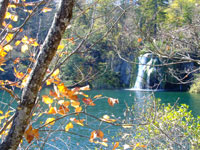
|
Events
Zagreb - Various
Some of the biggest names in the world arts scene head to the Croatian capital for a celebration of contemporary and classical styles of exceptional arts including music and dance at the Zagreb Biennale, which takes place every odd year.
| | 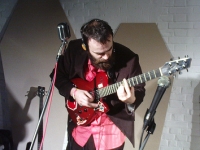 |
| International Puppet Festival |
Zagreb
Puppetry has a rich heritage across Europe and at the PIF (International Puppet Theatre Festival) the focus is on continuing the tradition and enjoyment of the art in an age of much technological distraction. Throughout the festival, puppeteers will reveal their trade and craft secrets that have thrilled children and adults for centuries. There will be a number of performances and general merriment all round.
| | 
|









No comments:
Post a Comment